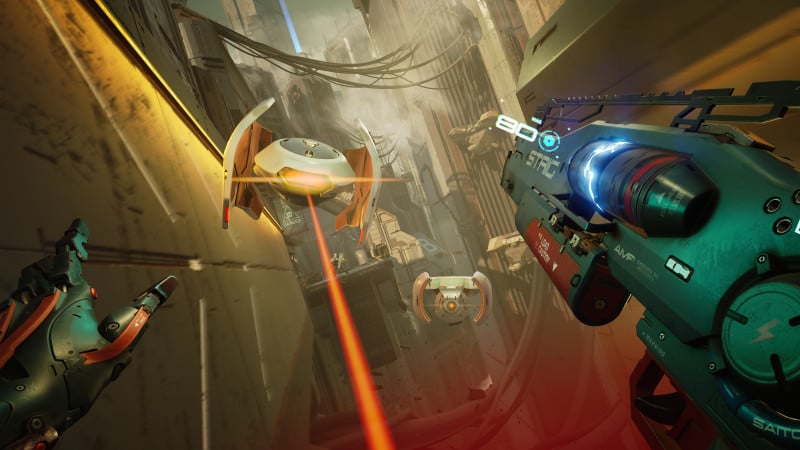Metal Eden Review – Shooting Through The Noise

Poland-based studio Reikon Games has only been around since 2014, but in its decade of development, it has made a name for itself creating stylish, action-forward cyberpunk games. Its debut, 2017’s Ruiner, was itself a great isometric shooter, but in hindsight, it was a look toward the studio’s future and its second game: Metal Eden. Like Ruiner, Metal Eden is a futuristic neon-lit shooter set in a cyberpunk dystopia, but this time, from a first-person perspective. It blends excellent first-person gunplay with movement tech that turns the city of Moebius into a parkour playground, and the resulting gameplay is hyper-fast, frantic, and fun. Though its narrative and level design sometimes get in the way of that, the entire package is still a setpiece-filled action romp and one of the year’s best shooters.
In the world of Metal Eden, Hyper Units are disposable androids capable of inhuman feats thanks to a cyberpowered armor that allows them to dash, grapple, jetpack, and wall-run through just about any environment, and each unit is trained for cybernetic warfare, with a seven-gun arsenal in tow. You play as Aska, a special Hyper Unit tasked with saving the citizens of Moebius from imminent destruction. That leads her through derelict factories, deserts, mining facilities, and into the realms of Engineers, who possess Cores she desperately needs for her mission. It’s a solid foundation for the 7-hour adventure, and a voice-in-your-comms doesn’t let you forget about it, sometimes to the detriment of the game.
While the voice acting is great, when you’re not engaged in multi-wave arena battles, there’s almost always a voice in your ear discussing their motives, their history, and their desires, all through sci-fi jargon that eventually bounced right off of me. Reikon is attempting to tell an enriched narrative, and I enjoy how much the studio focuses on walking players through Aska’s journey to save Moebius, which has been threatened with what is essentially a ticking time bomb; its finale leaves a lot to be desired, but I still found the overall story to be a commendable effort from Reikon. Its biggest flaw, though, is how often it gets in the way of the real star of Metal Eden: the action.
That said, the action was more than enough to pull me through each mission, as I constantly looked forward to the next setpiece, the next weapon, or even the next upgrade station to make my shotgun or grenade launcher more powerful. Metal Eden isn’t stingy with Dust, the currency used to upgrade weapons, found in canisters placed throughout levels or given upon defeating enemies. By the time I finished the game, only one of my seven weapons wasn’t fully upgraded, and I appreciate Reikon allowing me to unlock most of Aska’s potential in the first playthrough. Each weapon, whether it was the standard-issue submachine gun with unlimited ammo but a temperature-related cooldown, the energy weapon that melts enemy armor, or my personal favorite, an assault rifle with a secondary fire option that turns it into a powerful sniper, proved useful in combat. Firefights get so hectic that there were countless encounters where I used every single weapon at my disposal, whether it was a strategic need or because I ran out of ammo for another gun.
Though I always enjoyed the combat, I wish it were more diegetic rather than arena-based. My favorite moments were when Metal Eden channeled another Poland-based studio’s game, Ghostrunner, to turn linear sections into parkour runthroughs where I needed to kill enemies with quick precision to advance and maintain momentum. But most of the combat happened when I entered a large arena, and a random sci-fi voice told me when I finished a wave and when another wave was beginning. These arenas are well-designed, with armor, health, and ammo pickups strategically placed about, and excellent wall-running and grapple opportunities, too, but they still grew dull. It doesn’t help that the runs between these arenas were often the type of combat encounters I actually wanted more of.
Regardless, Aska only became more and more fun to use throughout Metal Eden as I unlocked more of my weapons’ potential and became more comfortable firing them while running on walls or grappling through the air, using my jetpack to extend my airtime. When I fully understood Aska’s set of weaponry and movement tech, and more importantly, how to take advantage of both in combat, each subsequent encounter felt like an extreme dose of adrenaline.
Similar to the narrative’s intrusion into the excellent first-person gameplay, there were a handful of times in Metal Eden where levels went wide, allowing Aska to morph into a ball – yes, it’s very reminiscent of Metroid Prime – where you zap enemies and target them with lock-on missiles. While cool in theory, these sections are easily the worst, and rolling around as a metal ball in no way compares to the excitement of first-person shooting, wall-running, and jetpacking through this dystopia.

Throughout my time in Metal Eden, I couldn’t help but imagine just how good a sequel I hope Reikon makes could be. This is a great start in the FPS genre for the team; its ideas are strong, and with refinement, Aska’s next mission could be as excellent as the Ghostrunner and Doom Eternal adventures it’s clearly inspired by. Though the star of the show – its first-person shooting and movement – is sometimes weighed down by an overreaching narrative and boring morph ball sections, when Metal Eden shines, it’s as bright as the sun that sheds light on Moebius’ dark underbelly.



